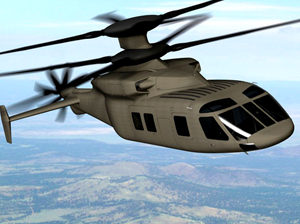 Scale is everything in rotorcraft: What works at one size might not at another, because of complex interactions between aerodynamics, propulsion, structures and control. That is why the U.S. Army plans to fly competing high-speed rotorcraft demonstrators before deciding which direction to take in replacing its utility and attack helicopters beginning in the mid-2030s.
Scale is everything in rotorcraft: What works at one size might not at another, because of complex interactions between aerodynamics, propulsion, structures and control. That is why the U.S. Army plans to fly competing high-speed rotorcraft demonstrators before deciding which direction to take in replacing its utility and attack helicopters beginning in the mid-2030s.
There are four options for the Army’s planned Joint Multi-Role (JMR) technology demonstrators. Bell Helicopter and Karem Aircraft each offer tiltrotors. AVX Aircraft offers a coaxial-rotor compound helicopter, as does a Sikorsky/Boeing team. Following completion of preliminary design, a downselect to two aircraft is planned for July 2014, leading to first flights at the end of fiscal 2017.
For Sikorsky, the challenge is to prove its coaxial rigid-rotor technology can be scaled up from the 8,000-lb. X2 Technology demonstrator that exceeded 250 kt. in 2010, through the 11,400-lb. S-97 Raider light tactical helicopter prototypes now being built to fly in 2014, to the 230-kt. Sikorsky/Boeing SB-1 Defiant JMR demonstrator—precursor to the Army’s planned 30,000-lb.-class Future Vertical Lift (FVL) medium utility rotorcraft to replace Sikorsky’s UH-60 Black Hawk.
Read more here.
Historically, vertical flight has required a compromise between hover performance and forward speed. The efficiency vs. speed graph on the right clearly illustrates the benefits of X2 TECHNOLOGY™. Low disk loading aircraft, such as helicopters, fall on the left of the graph, along with their desirable attributes (hover efficiency, low speed controllability, low downwash, hover endurance). Higher disk loading aircraft, such as Harriers and the Joint Strike Fighter (JSF), trade off speed for decreased hovering capabilities and increased operating costs. With X2 TECHNOLOGY™, Sikorsky is focused on providing increased speed over conventional rotorcraft designs without compromising the essential attributes that make helicopters valuable.
The Sikorsky X2 TECHNOLOGY™ demonstrator aircraft incorporates several new technologies and has successfully demonstrated them in a flight environment. These technologies include an integrated Fly-by-Wire system that allows the engine/rotor/propulsor system to operate efficiently, with full control of rotor rpm throughout the flight envelope, high lift-to-drag rigid blades, low drag hub fairings, and Active Vibration Control. In addition, the aircraft was used as a ‘flying wind tunnel’ to determine the main rotor to propulsor aerodynamic interaction, shaft angle optimization for performance, and blade tip clearance for a range of maneuvers. This will allow optimization of the X2 TECHNOLOGY™ suite for future products.
Having achieved its goal of flying the X2 Technology™ demonstrator helicopter at more than 250 knots (287 mph) — twice the average top speed of a traditional helicopter — Sikorsky will design, build and fly two more X2 Technology aircraft, and offer one of the aircraft to the U.S. Military for flight test and evaluation. Both prototypes will become the first of an all-new light tactical helicopter category — the Sikorsky S-97 — and will carry the designation S-97™ Raider™ helicopter.
Source: Sikorsky Aircraft Corp
Recent News: Sikorsky Moves X2 Technology Up A Size For JMR – November 4, 2013




